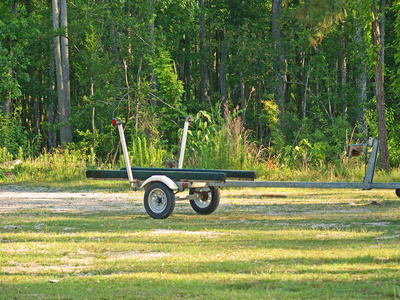A trailer has at least one axle, and you pull it behind another vehicle. Department of Transportation Section 108 outlines the requirements for lighting and reflective devices used on trailers. It details the size, color and placement of these lights. Light regulations in the U.S. and Canada are standard and apply to stock or horse trailers, utility and boat trailers, and trailers hauling motorcycles, jet-skis or ATVs. Pop-up campers and very small mobile homes must meet light requirements and lights must be working.

Trailers require a minimum of two red tail lights on the rear, as far apart as possible, to show vehicle width. You must have a minimum of two red brake lights mounted on the rear of the trailer and wired to the braking system. There must be two red or yellow turn signal lights mounted on the rear, as far apart as possible. Two red rear reflector lights are also required. A white light mounted on the rear illuminates the license plate, and two red rear side marker lamps must be far back on each side. You need at least two rear side red reflex reflectors, far back, facing sideways. A minimum of two yellow front side markers must be mounted on each side far forward. There should be a minimum of two yellow front side reflex reflectors, mounted far forward, facing sideward.

Longer trailers, in addition to basic lights, must have at least two amber, intermediate side marker lamps mounted near the center, facing sideward. There must be a minimum of two amber intermediate side reflex reflectors, near the center, facing sideward. These trailers also require working hazard lights.

In addition to basic lights, you must mount a minimum of two red rear clearance lights at the widest point on the rear to show the vehicle’s width, and they can’t be combined with tail lamps. You should mount them as high as is practical, and you can lower them only if identification lights are above. There must be three red rear identification lamps at the center, spaced horizontally 6 to 12 inches apart to show trailer width. In Canada, you may mount them lower if the door header is narrower than 25 mm. The front of the trailer must have a minimum of two amber clearance lamps, mounted facing forward, as high as practical, at the trailer’s widest point, far forward.

These trailers require basic lights, plus two pairs of 300 mm long white strips mounted at the top, on the rear upper corners, at the back of trailer. In the U.S., the rear bumper bar’s horizontal part must have a continuous red and white marking, as well as the rear portion of the lower part of the trailer, giving a candy-cane appearance to the bumper and any type of lower bar or bumper. This is common on flammable fuel and chemical tanker carriers. A similar, continuous red and white or yellow and white striped strip is required on each side of the trailer, extending front to back.
